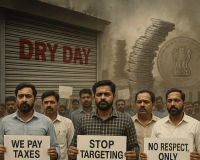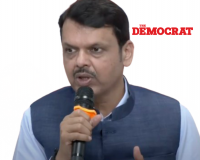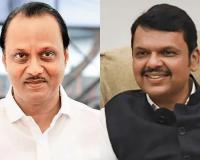- Editorial
- Unleashing the Indian Opposition
Unleashing the Indian Opposition
From Resistance to Renaissance
A Strategic Blueprint for an Opposition Resurgence by 2029 By Ujjwal K Chowdhury

The 2024 Indian general elections altered the landscape of Indian politics in a seismic way. While the ruling Bharatiya Janata Party (BJP) retained power through the National Democratic Alliance (NDA), its own tally of 240 seats fell short of the halfway mark—a stark contrast to its past two resounding mandates. On the other side, the Indian National Developmental Inclusive Alliance (INDIA) secured 234 seats, signalling a rejuvenated opposition and the beginning of a new democratic contest. The outcome was not a ringing endorsement of the incumbent but a clear signal of voter recalibration.
2029 is no longer a distant dream for the opposition. It is a winnable challenge. But the road to revival demands more than resistance—it calls for reinvention, institutional unity, and a credible, inclusive national alternative. The task is not simply to oppose the government but to present a coherent and hopeful vision for India's future, capable of neutralizing the incumbent's formidable financial, organizational, and institutional advantages.
A Reinvigorated Congress: From Dynasty to Democracy
The Congress Party, with its pan-India footprint and improved 2024 performance of 99 seats and a 21.4% vote share, must embrace its role as the fulcrum of the opposition alliance. But this leadership role hinges on transformation. Internal democracy must be more than symbolism—it must be institutionalized. The perception of a top-down, dynastic culture has long been the party's primary vulnerability. To credibly lead an alliance dedicated to defending democracy, the Congress must first become demonstrably democratic itself.
Transparent organizational elections, from the block level to the Congress Working Committee, are essential not only to deflect dynasty criticisms but also to rebuild moral credibility and unearth a new generation of energetic, mass-based leaders. A renewed Congress can no longer afford to act like a ‘first among all’—it must lead as a "first among equals," acknowledging and accommodating the strengths of key regional allies like the Samajwadi Party, DMK, and AITMC, whose contributions were pivotal to the INDIA bloc's 2024 success.
INDIA 2.0: From Electoral Arrangement to Institutional Coalition
The INDIA bloc must evolve from a tactical alliance into a permanent institutional force, ideally formalized by 2025. The fragility of ad-hoc arrangements is already apparent, with senior leaders expressing doubts about the bloc's future and some partners declaring the alliance was limited to the Lok Sabha polls. A last-minute coalition is a recipe for mistrust and public confusion. This transformation demands a federal and inclusive architecture with an Apex Steering Committee for strategic decisions, Coordination Committees for seat-sharing and campaign planning, a Common Secretariat for logistics, and a Joint Communication Cell to ensure message discipline.
Data-driven seat-sharing, based on the 2024 performance and independent surveys, must replace the chaotic ad-hocism that has plagued past efforts. More critically, all intervening state assembly elections must be fought together. This is not merely about winning individual states; it is a vital battle for the national narrative, essential for denying the BJP regional victories and sustaining the momentum gained in 2024.
Caste Census: Social Justice as Economic Reform
A nationwide socio-economic caste census must become the moral and political nucleus of the INDIA bloc’s agenda. The BJP may brand this as divisive, but the data—from Bihar to Telangana—prove otherwise: caste remains a fundamental determinant of economic deprivation. The Bihar survey revealed that Other Backward Classes (OBCs) and Extremely Backward Classes (EBCs) form over 63% of the state's population, with poverty disproportionately high among Scheduled Castes and Tribes.
By scientifically mapping backwardness through a 'Composite Backwardness Index' modelled on Telangana's pioneering effort, the opposition can reimagine affirmative action as data-led governance. This approach moves beyond population numbers to create a nuanced, data-driven measure of disadvantage. Linking this census to a Minimum Income Guarantee program will ensure benefits reach the most deprived—making welfare targeted, affordable, and morally compelling.
Economic Reboot: Relief, Jobs, and Equity
The opposition’s economic vision must be built on three pillars: relief, jobs, and equity. A bold proposal to make annual incomes up to ₹9 lakh completely tax-exempt directly addresses the salaried class’s frustration with perceived “tax terrorism”. Simplifying the convoluted Goods and Services Tax (GST) regime to a rationalized three-tier system would help small businesses and improve compliance.
Furthermore, the crisis of unemployment, with rates nearing 25% in states like Uttar Pradesh and Rajasthan, must be confronted head-on through filling government vacancies, launching entrepreneurship schemes, and reviewing the new labour codes to enhance job security. While headline inflation may seem moderate, the opposition must articulate a grounded economic message that focuses on the persistent high cost of living and offers a new direction prioritizing relief, fairness, and opportunity for all.
Human Capital Mission: 24% for the People
A truly game-changing commitment would be to allocate 8% of the central budget each to Education, Health, and Transport-Mobility. This is not just a promise—it is a fundamental re-prioritization of national development. Such an investment would represent a more than threefold increase over current allocations for education and a fourfold increase for health, empowering the National Education Policy with actual implementation muscle, modernizing healthcare delivery, and rejuvenating core infrastructure like Indian Railways. This "National Human Capital and Infrastructure Mission" reframes welfare as a strategic investment, laying the foundation for a productive, healthy, and mobile India capable of achieving its goal of becoming a developed nation.
Constitutional Patriotism: Reclaiming the Republic
The INDIA alliance must promise to restore the institutional integrity of India’s Republic. This begins with electoral transparency by pushing for increased VVPAT audits to restore public trust in EVMs, which has been a persistent concern despite the Supreme Court rejecting pleas for 100% verification. With India ranked a dismal 151st out of 180 countries in the World Press Freedom Index, the opposition must commit to dismantling media monopolies and protecting journalists.
The justice system itself shows a governance deficit, with the India Justice Report 2025 highlighting chronic court vacancies, under-staffed police forces, and dangerously overcrowded prisons. Fixing these systemic flaws is not optional—it is existential to democracy. Federalism and secularism must become non-negotiables. The INDIA bloc must become not just an electoral coalition, but a constitutional movement.
Winning the Narrative: From WhatsApp to the Working Class
The opposition’s Achilles' heel has been its messaging. That must end. A multi-tiered communication strategy should include a unified, emotionally resonant national slogan and a modern digital war room with a 24/7 disinformation counter-cell, data analytics unit, and influencer network to match the BJP's prowess. The messaging must be segmented and tailored to specific demographics—from a firm commitment to the 33% women's reservation for women voters to MSP guarantees for farmers and job security for the youth. Message discipline must finally match message diversity.
A Principled Foreign Policy: From Optics to Autonomy
The INDIA bloc must restore strategic autonomy to Indian foreign policy, moving beyond flashy optics and transactional alliances. Its core tenets must be rebuilding "Neighbourhood First" diplomacy, maintaining firmness on China while fostering friendship with all global blocs, and linking domestic economic credibility with a stable rupee and strong global standing. By championing multilateralism and reforms in global governance, India can reclaim its role as a responsible, balanced leader of the Global South.
Conclusion: A Coalition, A Constitution, A Country to Win
2024 was not the end of BJP dominance. It was the beginning of Indian democracy’s rebalancing. A reinvigorated Congress, a united INDIA bloc, and a transformative vision for social justice, economic revival, institutional renewal, and narrative control can together make 2029 a moment of democratic renewal. But this vision demands discipline, accommodation, and boldness. Seat-sharing must be pragmatic. Messaging must be sharp. Reforms must be real. The INDIA bloc must not merely oppose—it must offer a compelling alternative. 2029 is not a coronation for anyone. It is an open contest. The future belongs to those who prepare for it. And for the Indian Opposition, the time to prepare is now.
Prof Ujjwal K Chowdhury is a known commentator and media academic.
000
About The Author

Prof Ujjwal K Chowdhury is currently the Director General of Management School of Events, Entertainment and Design (MSEED) in the Bhavan's College campus of Andheri, and is also the Vice President of Global Media Education Council. He was till December, 2024, the Vice President, Global Marketing, International Relations, and Media-Design Education of Washington University of Science and Technology, based out of Virginia. He had been earlier the Pro Vice Chancellor of Kolkata based Adamas University, Dean of Symbiosis and Amity Universities, Pearl Academy and Whistling Woods International, all of India. He had been Dean of the Amsterdam Film School and Strategic Adviser of Daffodil International University of Bangladesh. He had worked in the World Health Organization, Times of India Group, Zee News and Business World. He runs a school for the talented children of marginalized fishermen families in the Sundarban area of Bengal and Bangladesh border.










.jpeg)
